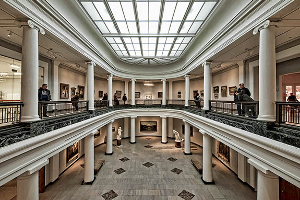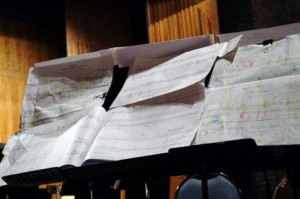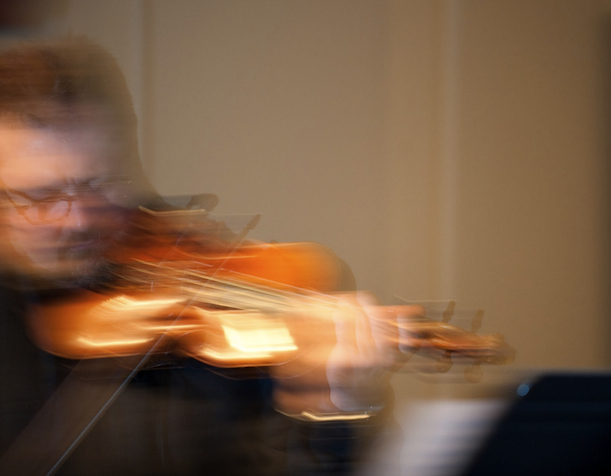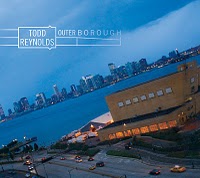 Monday night, the galleries of the Univeristy of Michigan Museum of Art (UMMA) were filled with the music of Stephen Harkte, John Harbison and Julia Wolfe thanks to the University of Michigan’s Contemporary Directions Ensemble (CDE) under the direction of its energetic and accomplished conductor Christopher James Lees. UMMA opened its doors to CDE in a collaborative exhibition of the evening’s music and a piece by Swiss artist Mai-Thu Pirret currently on display at the museum. The connection drawn between Mr. Hartke, Mr. Harbison, Ms. Wolfe and Ms. Perret’s output comes from the creators’ influences: extra-musical inspirations for the composers and, for Ms. Perret, the following quote from artist Sol Lewitt, “The Idea is the Machine Which Makes Art.”
Monday night, the galleries of the Univeristy of Michigan Museum of Art (UMMA) were filled with the music of Stephen Harkte, John Harbison and Julia Wolfe thanks to the University of Michigan’s Contemporary Directions Ensemble (CDE) under the direction of its energetic and accomplished conductor Christopher James Lees. UMMA opened its doors to CDE in a collaborative exhibition of the evening’s music and a piece by Swiss artist Mai-Thu Pirret currently on display at the museum. The connection drawn between Mr. Hartke, Mr. Harbison, Ms. Wolfe and Ms. Perret’s output comes from the creators’ influences: extra-musical inspirations for the composers and, for Ms. Perret, the following quote from artist Sol Lewitt, “The Idea is the Machine Which Makes Art.”
Before diving into the music, I’d like to spend a moment praising the concert’s setting on UMMA’s ground floor. Opposite the building’s main entrance, performers are recessed in a cathedral-esque nave where the sound reverberates wildly, resonating against the stone pillars, marble floors and masterworks of art lining the walls. Recently, the museum has made a habit of hosting performance groups associated with the University of Michigan, including last month’s triumphant standing-room-only performance of all six Brandenburg Concertos by a student early music ensemble under charismatic conductor/harpsichordist Brandon Straub. With unforgettable events like January’s Bach-extravaganza, and Monday’s intimate offering of contemporary music, the UMMA is one of the most exciting concert venues at Michigan.
Of course, a space is only as memorable as the music we experience within it, and Monday’s program was potent and profound, with each work demonstrating a different approach to the evening’s over-arching theme: outside influences. The first piece, Stephen Hartke’s The Horse with the Lavender Eye (1997), focuses on the idea of the non sequitur, and draws on sources from, “Carlo Goldoni to Japanese court music to the cartoonist R. Crumb, as well as 19th century Brazilian novelist Machado de Assis and Looney Tunes,” for its inspiration, according to the composer’s note.
A trio of clarinet, violin and piano, The Horse with the Lavender Eye unfolds in four seemingly isolated movements each of which has a strong individual identity. The second movement, “The Servant of Two Masters” is the best example of the movements’ idiosyncrasies as the piano alternatively serves the Clarinet and Violin of the course of its duration. The last two movements, “Waltzing in the Abyss” and “Cancel My Rhumba Lesson” make the clearest stylistic allusions of the work with hints at a waltz pulse and rhythmic and melodic tropes from early jazz and/or ragtime, respectively. As much as the movements feel disconnected – often,they just unravel, ending without a sense of closure, not least a strong connection to what follows – the whole work is held together by Mr. Hartke’s personal sense of rhythm, along with a very subtle reference between the first and last movements. A strong presence of rhythm, its transformative role in the music and – in particular – a rhythmic profile hovering on the boundaries of transparent grooves have always been prominent in my understanding of Mr. Hartke’s music and these elements were re-illuminated to me in the CDE’s performance of this composition.












